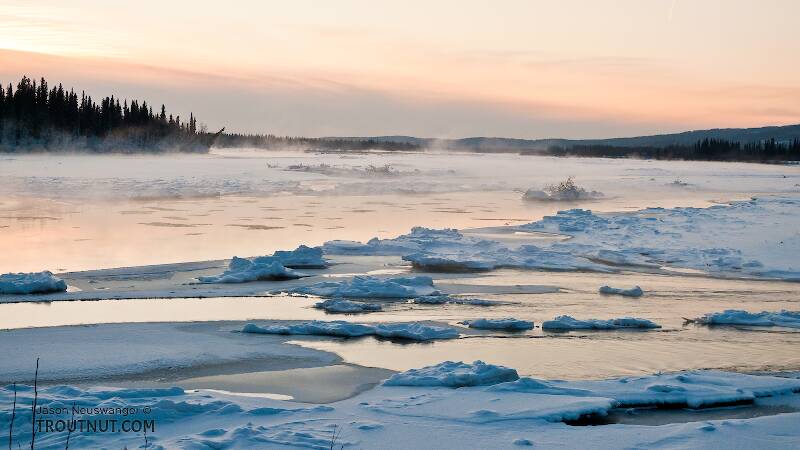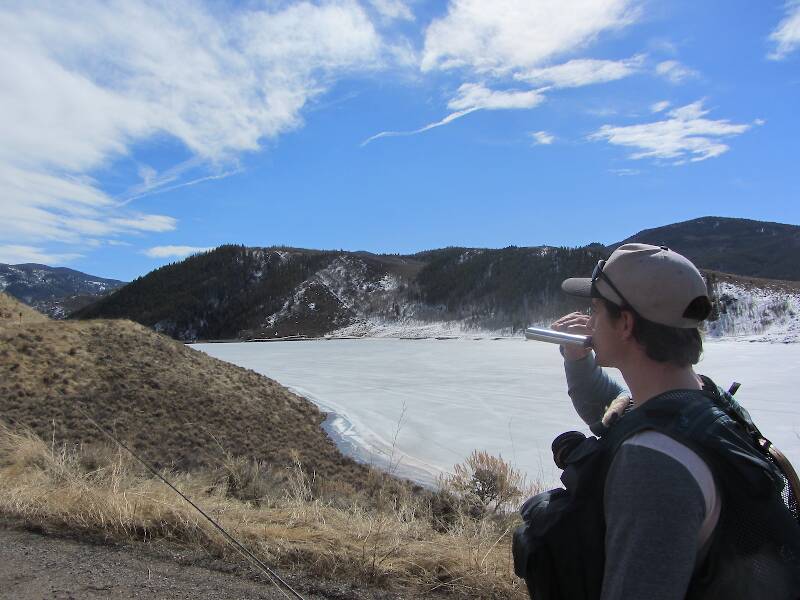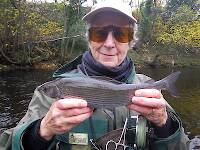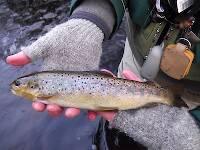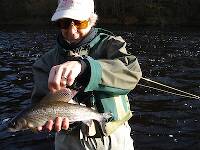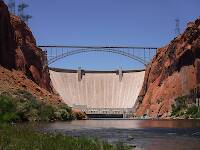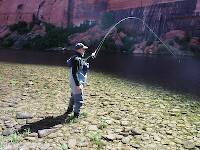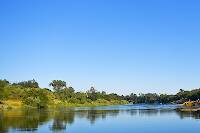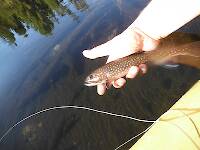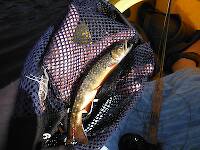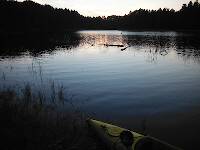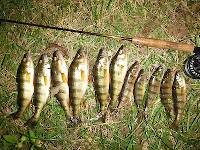
Hex Mayflies
Hexagenia limbata
The famous nocturnal Hex hatch of the Midwest (and a few other lucky locations) stirs to the surface mythically large brown trout that only touch streamers for the rest of the year.
Featured on the forum

Troutnut is a project started in 2003 by salmonid ecologist Jason "Troutnut" Neuswanger to help anglers and
fly tyers unabashedly embrace the entomological side of the sport. Learn more about Troutnut or
support the project for an enhanced experience here.
West on Mar 17, 2009March 17th, 2009, 1:50 pm EDT
This is more of a fishing report, but I'm interested to see what others who have been out fishing Northern Wisconsin's early season have tied into.
I was out today and the air temp was in the 60s (estimated). The river was running perfect, still amazingly low, and there were good sized (16 or so) stoneflies spiraling downward and bumbling about on the surface. Lots of them!
I saw a total of four fish rise, one of which I hooked. I am by no means complaining, but was surprised to not see more fish coming to the surface to grab these easy meals. I suppose I should be blessed to find any trout this early in the season rising to decent-sized insects, but the weather conditions were just too perfect and there were so many bugs on the water that it almost seemed unfitting not to see the river alive with porpoising trout.
They were also surprisingly discriminatory of the nymphs that we were throwing at them most of the afternoon, with one hooked fish on a black stonefly nymph the only one to show considerable interest.
So if anyone else has a Northern Wisconsin Early Season '09 tale they'd like to share, I'll be an eager listener...
I was out today and the air temp was in the 60s (estimated). The river was running perfect, still amazingly low, and there were good sized (16 or so) stoneflies spiraling downward and bumbling about on the surface. Lots of them!
I saw a total of four fish rise, one of which I hooked. I am by no means complaining, but was surprised to not see more fish coming to the surface to grab these easy meals. I suppose I should be blessed to find any trout this early in the season rising to decent-sized insects, but the weather conditions were just too perfect and there were so many bugs on the water that it almost seemed unfitting not to see the river alive with porpoising trout.
They were also surprisingly discriminatory of the nymphs that we were throwing at them most of the afternoon, with one hooked fish on a black stonefly nymph the only one to show considerable interest.
So if anyone else has a Northern Wisconsin Early Season '09 tale they'd like to share, I'll be an eager listener...
West
http://pleasantly-obsessed.blogspot.com/
http://pleasantly-obsessed.blogspot.com/
DOS on Mar 17, 2009March 17th, 2009, 3:25 pm EDT
Hey West,
I have had similar observations here in Upstate NY. Although the air temperatures have been in the 50's and 60's for several days, most of our creeks are hovering in the low 40's. With water temperatures that cold, the trout are still quite sluggish and in a kind of reduced metabolic malaise. The trout will do anything it can to expend as little energy as possible, which includes refraining from rising to a insect or moving for a nymph. Until water temperatures reach about 50F, I think you will see less than spunky trout in your water.
I would assume your creeks in Northern Wisconsin are at about the same temperatures but it would be good to get a cheap digital thermometer like the ones made for aquariums, with a 6 or 8 foot probe. I know you can get them at PetCo. for $10. Also, make sure you calibrate the thermometer before using it in the field.
I have had similar observations here in Upstate NY. Although the air temperatures have been in the 50's and 60's for several days, most of our creeks are hovering in the low 40's. With water temperatures that cold, the trout are still quite sluggish and in a kind of reduced metabolic malaise. The trout will do anything it can to expend as little energy as possible, which includes refraining from rising to a insect or moving for a nymph. Until water temperatures reach about 50F, I think you will see less than spunky trout in your water.
I would assume your creeks in Northern Wisconsin are at about the same temperatures but it would be good to get a cheap digital thermometer like the ones made for aquariums, with a 6 or 8 foot probe. I know you can get them at PetCo. for $10. Also, make sure you calibrate the thermometer before using it in the field.
Andrew Nisbet
West on Mar 19, 2009March 19th, 2009, 3:56 am EDT
I think you could be right about the water temps. I know it can take the trout in any river a while to "warm up" to the notion of rising to a winged insect.
I recently ordered a william and joseph digital thermometer after losing the one I had last season (they work great and cost about 25$, if anyone's wondering) but unfortunately it didn't come in time for spring break so I am without any water temp records.
I did, however, make it out again yesterday with a friend and the trout were a bit more cooperative. The air temp was cooler, in the high 30's, and there was a few stones on the water, none of which drew any rises that I saw. But we did manage to land three fish over 16" and a few other smaller trout, a much better outcome than the previous day.
I think that at this time of year, a person can get lucky by making it out once or twice and hitting it right, and there are many winter techniques that a person can use to increase their chances, but to count on success you have to make a point of hitting the water numerous times within the same or adjacent weather patterns (i.e. 4 or 5 days in succesion).
Personally, any success this early in the year is enough to leave me cursing when a nice day comes along and I can't get to the river.
I recently ordered a william and joseph digital thermometer after losing the one I had last season (they work great and cost about 25$, if anyone's wondering) but unfortunately it didn't come in time for spring break so I am without any water temp records.
I did, however, make it out again yesterday with a friend and the trout were a bit more cooperative. The air temp was cooler, in the high 30's, and there was a few stones on the water, none of which drew any rises that I saw. But we did manage to land three fish over 16" and a few other smaller trout, a much better outcome than the previous day.
I think that at this time of year, a person can get lucky by making it out once or twice and hitting it right, and there are many winter techniques that a person can use to increase their chances, but to count on success you have to make a point of hitting the water numerous times within the same or adjacent weather patterns (i.e. 4 or 5 days in succesion).
Personally, any success this early in the year is enough to leave me cursing when a nice day comes along and I can't get to the river.
West
http://pleasantly-obsessed.blogspot.com/
http://pleasantly-obsessed.blogspot.com/
Wiflyfisher on Mar 19, 2009March 19th, 2009, 2:09 pm EDT
Hi West,
You might also look beneath the surface to see what could be an esiaer meal for the trout. Possibly, drowned stonefles? A small seine might help give you some clues. Also, far dwonstream the water temps will be slightly warmer.
What bothers me is you said "still amazingly low", which is not good for the NW corner in mid-March. In the southern half of the state all the rivers are swollen and most are over their banks. I know Drummond had to truck in snow for their mid-Feb. famous bar stool races. I hope the NW area gets some serious precipitation.
By th way, how is Brad?
You might also look beneath the surface to see what could be an esiaer meal for the trout. Possibly, drowned stonefles? A small seine might help give you some clues. Also, far dwonstream the water temps will be slightly warmer.
What bothers me is you said "still amazingly low", which is not good for the NW corner in mid-March. In the southern half of the state all the rivers are swollen and most are over their banks. I know Drummond had to truck in snow for their mid-Feb. famous bar stool races. I hope the NW area gets some serious precipitation.
By th way, how is Brad?
John S.
https://WiFlyFisher.com
https://WiFlyFisher.com
West on Mar 19, 2009March 19th, 2009, 4:28 pm EDT
The action did seem to be a bit more steady downstream from Phipps, possibly due to the slightly warmer water temps...
John,
I could be wrong in my presumption, but I would say that on the whole the rivers up here are overall in pretty good shape...part of the reason I was surprised that the water was so low was that there is still plenty of snow in the woods in most areas (thinning out as you go S. toward Hayward) and the air temperatures have been so high that I was expecting water levels to maybe be a bit higher as well. I am now also more aware of the Namekagon's ability to stay fishable as other rivers around the area can blow out, so that was another reason I was surprised that it was so clear. Some precip. here couldn't hurt, but I think that there's enough water above and in the ground that the rivers should be healthy for a while. I'm no scientist though...
I unfortunately have not seen Brad lately. I missed the Great Waters Expo at the last second and was at his house yesterday visiting his English Setter pups but right now he's in Arizona and California. Sounds like there's maybe some rainbow lakes that a friend's introducing him to out there. Hope to get fishing with him soon though; he's had a lot on his plate lately getting this new Musky Country Outfitters going.
Saturday's the next and last scheduled assault on the Nam before I go back to school. I'm hoping the trout are as excited by this weather as I have been.
John,
I could be wrong in my presumption, but I would say that on the whole the rivers up here are overall in pretty good shape...part of the reason I was surprised that the water was so low was that there is still plenty of snow in the woods in most areas (thinning out as you go S. toward Hayward) and the air temperatures have been so high that I was expecting water levels to maybe be a bit higher as well. I am now also more aware of the Namekagon's ability to stay fishable as other rivers around the area can blow out, so that was another reason I was surprised that it was so clear. Some precip. here couldn't hurt, but I think that there's enough water above and in the ground that the rivers should be healthy for a while. I'm no scientist though...
I unfortunately have not seen Brad lately. I missed the Great Waters Expo at the last second and was at his house yesterday visiting his English Setter pups but right now he's in Arizona and California. Sounds like there's maybe some rainbow lakes that a friend's introducing him to out there. Hope to get fishing with him soon though; he's had a lot on his plate lately getting this new Musky Country Outfitters going.
Saturday's the next and last scheduled assault on the Nam before I go back to school. I'm hoping the trout are as excited by this weather as I have been.
West
http://pleasantly-obsessed.blogspot.com/
http://pleasantly-obsessed.blogspot.com/
Troutnut on Mar 19, 2009March 19th, 2009, 9:33 pm EDT
Hey West,
Based on my one season fishing the Namekagon hard in March, I'm surprised you saw any fish rising. I had some outstanding fish on the nymphs on days like the one you describe, though. I used a two-nymph rig, a Taeniopteryx stonefly imitation and a pink squirrel.
The key for me was to just hammer the best-looking spots, sometimes with over fifty casts each. The water's still cold and the fish won't usually move very far for food, but they'll take it if you run it right by their nose enough times. Sometimes it took several "perfect" casts to get one in which the nymphs drifted just right, I think.
Based on my one season fishing the Namekagon hard in March, I'm surprised you saw any fish rising. I had some outstanding fish on the nymphs on days like the one you describe, though. I used a two-nymph rig, a Taeniopteryx stonefly imitation and a pink squirrel.
The key for me was to just hammer the best-looking spots, sometimes with over fifty casts each. The water's still cold and the fish won't usually move very far for food, but they'll take it if you run it right by their nose enough times. Sometimes it took several "perfect" casts to get one in which the nymphs drifted just right, I think.
Jason Neuswanger, Ph.D.
Troutnut and salmonid ecologist
Troutnut and salmonid ecologist
Wiflyfisher on Mar 19, 2009March 19th, 2009, 11:43 pm EDT
West, what is "Musky Country Outfitters"?
Ya, it takes a lot of rain or runoff to blow out the Namekagon. Unlike some of the Lake Superior streams that I am sure you fish.
Jason gives some great advise for fishing this time of year. An strike indicator can really help too.
I thought I read somewhere from Pratt that there are less mid-size fish but an increase in fish over 15" this season. Plus, more offspring last year that hopefully have survived.
John
Ya, it takes a lot of rain or runoff to blow out the Namekagon. Unlike some of the Lake Superior streams that I am sure you fish.
Jason gives some great advise for fishing this time of year. An strike indicator can really help too.
I thought I read somewhere from Pratt that there are less mid-size fish but an increase in fish over 15" this season. Plus, more offspring last year that hopefully have survived.
John
John S.
https://WiFlyFisher.com
https://WiFlyFisher.com
West on Mar 20, 2009March 20th, 2009, 5:51 pm EDT
Thanks for the early season advice Jason...I've been using a two-nymph rig almost exclusively this spring. It's good to hear your 50-casts approach. I like that; knowing I still have a chance after that many casts is a confidence boost for sure.
Musky Country Outfitters, from what Brad has described to me, is a guiding business that he's getting started this year out of Hayward, and concentrating on mostly warmwater. It seems to be a massive work in progress for him this past season and is pretty exciting. I'll hopefully be down in Hayward this summer helping out, that's the plan anyway. He's also started a scholarship program that's pretty cool called Afton Angler Scholarship, of which I was the first recipient in 2008, going each year to a young steward of fly fishing (blush).
One more thing: I haven't fished the Namekagon enough to really have a sound conclusion on this, but the "more fish over 15 inches" seems pretty appropriate for the fish that we've been hooking up with this spring. My buddy was out yesterday and between him and a friend or two, pulled three 20" browns out of a single run. It's no secret: That river holds a shitload of big browns!
Musky Country Outfitters, from what Brad has described to me, is a guiding business that he's getting started this year out of Hayward, and concentrating on mostly warmwater. It seems to be a massive work in progress for him this past season and is pretty exciting. I'll hopefully be down in Hayward this summer helping out, that's the plan anyway. He's also started a scholarship program that's pretty cool called Afton Angler Scholarship, of which I was the first recipient in 2008, going each year to a young steward of fly fishing (blush).
One more thing: I haven't fished the Namekagon enough to really have a sound conclusion on this, but the "more fish over 15 inches" seems pretty appropriate for the fish that we've been hooking up with this spring. My buddy was out yesterday and between him and a friend or two, pulled three 20" browns out of a single run. It's no secret: That river holds a shitload of big browns!
West
http://pleasantly-obsessed.blogspot.com/
http://pleasantly-obsessed.blogspot.com/
TheFlyMaste on Apr 17, 2009April 17th, 2009, 6:54 am EDT
I know this post is a little old. But when someones mentions the Nam, it sends chills down my spine, in a good way of course. There are some good pointers on fishing the Nam in this post, but don't be afraid to break out the big stuff. There are a lot of non insects in that river as well. My .2 for the day.
West, don't know if you remember me, but it was nice to meet you. Cool to put a face to a forum poster.
You going to take over Brads job on the Brule?
West, don't know if you remember me, but it was nice to meet you. Cool to put a face to a forum poster.
You going to take over Brads job on the Brule?
Ouitdee Carson
Arrowhead Fly Angler
Arrowhead Fly Angler
West on Apr 20, 2009April 20th, 2009, 6:23 am EDT
Hey there Ouitdee,
Yeah I do remember you. You gave me a lift from Winneboujou to Big Lake one day...and it was nice meeting you as well.
I think I'll probably be down in Hayward for much of this summer helping Brad with Musky Country Outfitters, providing he can keep me fairly busy. But I also hope to get to the Brule a fair share to hit the many hatches and hot periods that I've had time to study and fish over the past two seasons.
But as for breaking out the big stuff, I also expect that to be a good strategy this time of year (especially now when the water temps are getting substantially warmer). With all the crayfish, leeches and minnows in the river, there's no reason to believe that a large imitation of prey, maybe fished a bit slower than in the summer, should attract some comparatively-sized trout.
Yeah I do remember you. You gave me a lift from Winneboujou to Big Lake one day...and it was nice meeting you as well.
I think I'll probably be down in Hayward for much of this summer helping Brad with Musky Country Outfitters, providing he can keep me fairly busy. But I also hope to get to the Brule a fair share to hit the many hatches and hot periods that I've had time to study and fish over the past two seasons.
But as for breaking out the big stuff, I also expect that to be a good strategy this time of year (especially now when the water temps are getting substantially warmer). With all the crayfish, leeches and minnows in the river, there's no reason to believe that a large imitation of prey, maybe fished a bit slower than in the summer, should attract some comparatively-sized trout.
West
http://pleasantly-obsessed.blogspot.com/
http://pleasantly-obsessed.blogspot.com/
Quick Reply
Related Discussions
Topic
Replies
Last Reply
3
Sep 25, 2015
by Oldredbarn
by Oldredbarn

